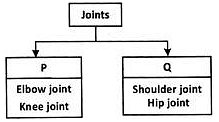Class 6 Exam > Class 6 Tests > Science Class 6 > Olympiad Test: Body Movements - Class 6 MCQ
Olympiad Test: Body Movements - Class 6 MCQ
Test Description
20 Questions MCQ Test Science Class 6 - Olympiad Test: Body Movements
Olympiad Test: Body Movements for Class 6 2024 is part of Science Class 6 preparation. The Olympiad Test: Body Movements questions and answers have been
prepared according to the Class 6 exam syllabus.The Olympiad Test: Body Movements MCQs are made for Class 6 2024 Exam. Find important
definitions, questions, notes, meanings, examples, exercises, MCQs and online tests for Olympiad Test: Body Movements below.
Solutions of Olympiad Test: Body Movements questions in English are available as part of our Science Class 6 for Class 6 & Olympiad Test: Body Movements solutions in
Hindi for Science Class 6 course. Download more important topics, notes, lectures and mock
test series for Class 6 Exam by signing up for free. Attempt Olympiad Test: Body Movements | 20 questions in 20 minutes | Mock test for Class 6 preparation | Free important questions MCQ to study Science Class 6 for Class 6 Exam | Download free PDF with solutions
Detailed Solution for Olympiad Test: Body Movements - Question 1
Detailed Solution for Olympiad Test: Body Movements - Question 2
| 1 Crore+ students have signed up on EduRev. Have you? Download the App |
Olympiad Test: Body Movements - Question 3
Which characteristic feature helps human being to walk upright?
Detailed Solution for Olympiad Test: Body Movements - Question 3
Detailed Solution for Olympiad Test: Body Movements - Question 4
Detailed Solution for Olympiad Test: Body Movements - Question 5
Olympiad Test: Body Movements - Question 6
Which of the following moves by contraction and expansion of the body?
Detailed Solution for Olympiad Test: Body Movements - Question 6
Detailed Solution for Olympiad Test: Body Movements - Question 7
Olympiad Test: Body Movements - Question 8
An organism X can walk, and climb on a surface and can also fly in the air. Which organism is X?
Detailed Solution for Olympiad Test: Body Movements - Question 8
Detailed Solution for Olympiad Test: Body Movements - Question 9
Olympiad Test: Body Movements - Question 10
Which two body systems most directly cause the arm to bend?
Detailed Solution for Olympiad Test: Body Movements - Question 10
Olympiad Test: Body Movements - Question 11
Which of the following represents X and Y in the figure given below?

Detailed Solution for Olympiad Test: Body Movements - Question 11
Detailed Solution for Olympiad Test: Body Movements - Question 12
Olympiad Test: Body Movements - Question 13
Which part of body is protected by the vertebral column?
Detailed Solution for Olympiad Test: Body Movements - Question 13
Detailed Solution for Olympiad Test: Body Movements - Question 14
Olympiad Test: Body Movements - Question 15
Which type of movement is possible for the joint at forearm and knee?
Detailed Solution for Olympiad Test: Body Movements - Question 15
Detailed Solution for Olympiad Test: Body Movements - Question 16
Olympiad Test: Body Movements - Question 17
Which of the following joints and their parts enable a bowler to bowl, while playing cricket?
Detailed Solution for Olympiad Test: Body Movements - Question 17
Olympiad Test: Body Movements - Question 18
Skeletal and muscular systems work together to enable the body to move. What is the main function of the skeletal system in relationship to the muscular system?
Detailed Solution for Olympiad Test: Body Movements - Question 18
Detailed Solution for Olympiad Test: Body Movements - Question 19
Detailed Solution for Olympiad Test: Body Movements - Question 20
|
99 videos|261 docs|49 tests
|
Information about Olympiad Test: Body Movements Page
In this test you can find the Exam questions for Olympiad Test: Body Movements solved & explained in the simplest way possible.
Besides giving Questions and answers for Olympiad Test: Body Movements, EduRev gives you an ample number of Online tests for practice


















